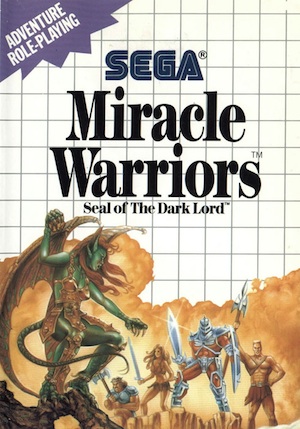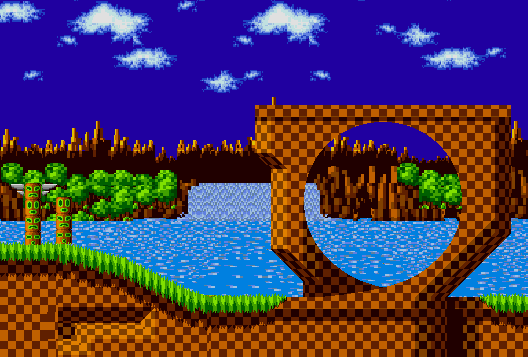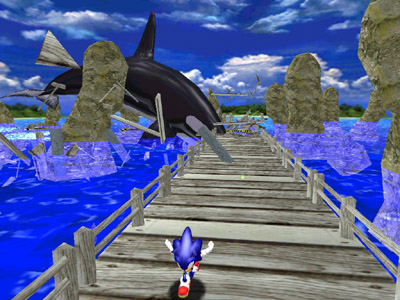Last updated on October 25, 2012
Sonic the Hedgehog and I have never been on particularly good terms. That doesn’t mean I don’t love him, but he continues to make mistake after mistake and I simply can’t deal with him all the time. He’s one of those friends where you’re satisfied after he sees you for the first time in a year, just to catch up on what was going on. Then you remember why you don’t see him as often – his self-important discussion topics, his vague attempts at advancing himself, his lack of motivation to do much of anything. He’s a likable guy, but he hasn’t aged well.
I owned a Genesis back in the day, being one of those lucky few to have both 16-bit system in the house. However, my Sega experience was typified by the Sega Master System more than the Megadrive (nerdy pun right here). In fact, I’d say I played Sega games more than Nintendo games in my childhood – Golvellius, Shinobi, Afterburner, whatever racing/shooting game came packed in the system, and Miracle Warriors: Seal of the Dark Lord (I had to look that up to even know what it was, though!) were more a part of my childhood than Mario, to be honest. The NES only came later, and when it did arrive Mario was a revelation of the highest order. We needed MORE. When the Genesis came out, we chose the Super Nintendo as Super Mario World looked so enticing. The choice was definitely the right one, looking back. Having gotten a Genesis a few years later, Sonic wasn’t necessarily something you needed or desired. Hey, it came packed with the system, so why not?

The first Sonic game failed to impress. Sonic’s meant to be fast – well, apparently that speed was limited to everyone’s favorite stage, Green Hill Zone. This first set of stages sets the tone of “fast fast fast” which Sonic tries to capture. All that “blast-processing” had some effect, I guess, and Sonic was a FAST game for the early 1990s. That unique characteristic made Sonic’s first adventure an instant classic in the eyes of Sega fans yearning for a mascot with ‘tude, but it hasn’t aged particularly well. It encouraged memorization in order to avoid enemies (who would break your momentum) and get the most rings. Get fifty rings by the end of a stage, and you enter the bonus stage, where the Chaos Emeralds lay. Obtain all the Chaos Emeralds, and you get a special ending.
Doing any of this, and being fast throughout a stage, was easier said than done! Every zone after Green Hill required nagivation through some intense obstacles courses – much harder than Mario’s equivalents, I’d wager. I’ve died more than my fair share in Marble Zone, which has lava, spike pits, enemies that can’t be killed by merely jumping on them, spike chandeliers that can kill or squish Sonic, and many difficult jumping segments. Honestly, Sonic’s first adventures threw this little kid into the adult pool without teaching him how to swim!
Any kid isn’t going to take that experience lightly, and I never played the first game extensively. Rather, my entry into the series was the much more generous and kind Sonic 2 – overall, though, I never really enjoyed Sonic games. They felt…repetitive. Too fast to make the obstacles anything more than cheap placeholders for real challenge and design.
Having finally returned to the first Sonic game again, I find my original opinions vindicated. Sure, it’s a beautiful game with a great soundtrack, but it doesn’t light my fire in any way. Marble Zone got me just as it did two decades ago. In fact, I was surprised to learn that the tight controls weren’t as accurate as I remember. Glitches abound whenever you try to use the invisibility powerups – I ran through lava while having it, only to find myself die for no discernible reason. I also was crushed when invincible, which threw the game for a loop and caused the screen to scroll rapidly and then Sonic died. You would think the possibility of these situations would arise within Sonic Team, but apparently not! The speed causes its own problems. Sonic Adventure, the first real 3D Sonic game, has the exact same problems with its countless loop-de-loop deaths and camera angles that obscure the action. Those who pine for the “Sonic” of the past obviously don’t remember the same flaws continuing from the past, but they certainly exist.
Yet, I don’t find myself angry at the game at all. Rather, Sonic still remains a unique experience in the realm of console games, even the horrible and much maligned Sonic reboot of 2006 (that deserves a whole article in itself). There’s a charm in its simplicity that goes for one central concept, yet still challenges the player to overcome its unique obstacles. The set-pieces of every Sonic Team game amaze frequently as you’ll find yourself in a variety of colorful and insane situations. The frequent deaths hardly break the games; they just make you try harder to reach the end goal with quickness and panache. That’s something that even Mario doesn’t provide: a reckless sense of constant endangerment. I suppose that’s why they have rings, right?
Still, the Sonic series ALWAYS requires you to put up with the bizarre predilictions of Sonic Team, at least in the modern incarnations. Most of them read like a horrible version of Dragon Ball Z, with Chaos Emeralds, humans (!!!) and scientific experiments playing a major part in the disposable “plots”. Sonic ’06 (the reboot) even introduces time travel and apocalypse – not exactly the kind of things I need in my anthropomorphic speedy animal simulator. If not for the cheese factor alone, there’s a perverse pleasure in watching game developers try to write serious plots with talking animals. For example:
Mephiles the Dark is one of the main antagonists of the game Sonic the Hedgehog (2006). He is the conscience, mind, and will of the sun god Solaris, ultimately making him the main antagonist of the game’s story.
Uh, what? Ok, sun god Solaris, right? Yeah, makes perfect sense – why not have an extraterrestial space demon in a Sonic game? Was Robotnik/Eggman not evil enough? But who’s playing Sonic for the story (I hope you aren’t, dear reader!). Or who’s playing it for the extensive Sonic mythos? If you are, you’re doing it wrong.
Still, video game fans have been putting up with the continual flaws of Sonic for years now, and it hasn’t stopped yet. What other mascot continues to survive? Remember Crash Bandicoot? Spyro the Dragon? Bonk (that one’s a stetch, I know)?Where did those guys go? Sonic continues to trudge along with a new installment (or several) every years while similar mascots smashed into the dust bin of history (Nintendo characters are notable exceptions). Why do we continue to like Sonic even as he disappoints and succeeds from year to year?
Unlike the Seiken Densetsu series, Sonic always provides the same core game, regardless of how horribly flawed its current form takes. The concept always succeeds at some level, and when it’s good, it’s VERY GOOD. Sonic Adventure 2 strikes me as a notable example of this – sure, there’s stupid treasure hunting sequences and mech run’n’gun, but the speed stuff shows some inspired work. Sonic Generations was another knock out for the public at large that wrote Sonic off as yet another failed franchise. The one concept – speed – works in whatever context they dump the Blue Blur, which makes Sonic Team’s decision-making processes a fascinating trial and error. He tries to improve continually, yet comes up short frequently.
We still all love him, though! “Hate the sin, love the sinner” is the Christian platitude I find most driven into the ground of self-parody, but it applies so perfectly here. Like us, Sonic continues to stumble and fall, but he always gets back up – with an attitude that won’t quit. I think we know Sonic Team’s intentions always want to please the players, yet they frequently bog themselves down by looking for love in all the wrong places. Yet I want Sonic games to work and blow me away – they do, at times. This makes Proverbs 24 an interesting addition to the conversation:
16 For a righteous man falls seven times, and rises again,
But the wicked stumble in time of calamity.
17 Do not rejoice when your enemy falls,
And do not let your heart be glad when he stumbles;
18 Or the Lord will see it and be displeased,
And turn His anger away from him.
I wouldn’t call Sonic wicked, by any stretch, but we stumble and fall as well; some of us get back up, and others do not. Yet we should want everyone to succeed in doing what is righteous, but never wish evil upon those who do evil. We should rejoice when they turn away from evil to good:
4 “You shall say to them, ‘Thus says the Lord,
“Do men fall and not get up again?
Does one turn away and not repent?
5 “Why then has this people, Jerusalem,
Turned away in continual apostasy?
They hold fast to deceit,
They refuse to return.– Jeremiah 8
The continual learning process has, at times, tried even the most hardcore of Sonic’s fan, yet they hope for success for this blue cartoon character. Now I think I understand why: because we desire the same improvement for ourselves. We point out flaws, we fix them, we move on and do even greater things, righteous things. That’s what makes living with Sonic a relevant, if tumultuous, relationship, but one we experience everyday – we see ourselves in it.


